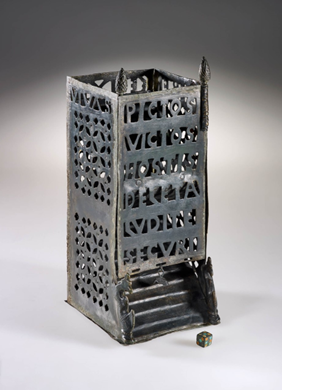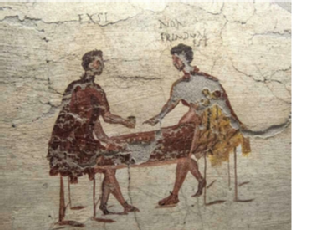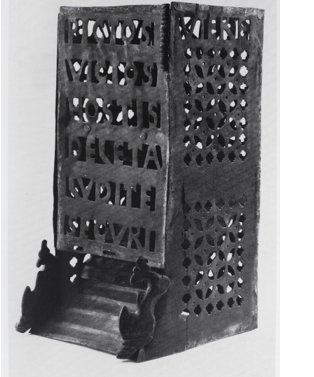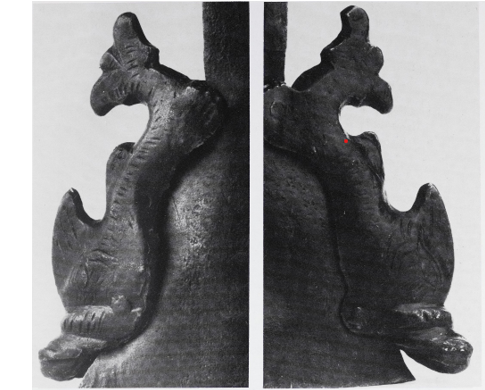Just a Game? An ancient dice tower and Roman society - Will Vernon
It is easy to think of gaming as a trivial aspect of our daily lives, as being ‘just a game’. But for students in fields like history, archaeology and anthropology, games can offer insights into a given society by reflecting on aspects such as the social, political and cultural activities of a given time.
These insights are demonstrable by popular boardgames within living memory. Risk, for instance, a game with the objective of world domination through conquest, gained popularity concurrent with the beginnings of The Cold War.

Figure 1 – A detail of the Risk boardgame.
Image credit: Tom Page at https://www.flickr.com/photos/tompagenet/8585345251
More recently, Pandemic Legacy, experienced a surge in sales in Australia during the country’s first Covid-19 related lockdown in March 2020. The game offers the player the opportunity to cooperatively eradicate the world from a deadly virus that is threatening humanity.
These two examples show the potential that games can contribute to our understanding of our own modern societies. But archaeological evidence indicates that humanity has gamed for at least 5000 years, thus offering the potential to better understand civilizations from the ancient world.
In this blogpost, we will take a journey to the Roman Empire in the 4th century AD, a period when Rome’s golden age had long passed, a time when Rome’s enemies were becoming an increasingly prominent concern for many within its borders. This will be achieved with analysis of a Roman gaming device known today as the ‘Vettweiss-Froitzheim Dice Tower’, let me introduce it to you…
The Vettweiss-Froitzheim Dice Tower

This Dice Tower (left) was discovered during an excavation of a Roman Villa in 1983 in Vettweiss, Germany. Because of its deteriorated condition upon discovery, it was reconstructed at the Landesmuseum Bonn - where it can still be found today.
The Latin Inscription on the front reads: ‘PICTOS/VICTOS/HOSTIS/DELETA LUDITA’ translating to “The Picts are conquered, the enemy destroyed-play in safety”
The Latin inscription on the sides reads: ‘UTERI/FELIX/VIVAS’ translating to ‘Use happily; may you live well’.
The device dates to the 4th Century AD and is believed to have been used alongside Alea (games of chance played by the Romans that involved the use of dice, a board and game pieces), ultimately, to ensure the fair roll of the dice. Both its militaristic features and the large Roman military presence within proximity of the villa suggest that it is likely to have belonged to a Roman soldier.
Figure 2 (left). The Vettweiss-Froitzheim Dice Tower, LVR-LandesMuseum, Inv.No. 1985.269,0-1
Height 225mm, Diameter 95mm. Images reproduced here with the kind permission from J. Vogel, LVR-LandesMuseum Bonn
The Picts are Conquered, the enemy destroyed- Play in Safety
To the modern observer, the dice tower’s Latin inscription (Fig. 2) can be problematic. On one hand, it communicates a positive message – a reminder of their conquest over their enemies and their ability to subsequently play such games without worry.
But it may not truly reflect the feelings felt by a Roman soldier protecting the empires’ Germanic borders in the 4th century. In fact, the enemy was far from destroyed. The Picts were just one faction in the period to trouble the empire alongside others, like the Goths, or internally through civil war. Indeed, if the owner of the object was a Roman soldier, any threat that may have felt would have been justified; the Romans would soon retreat from the area, abandoning the villa between 380-390 AD.
As is demonstrated with modern boardgames like Risk and Pandemic Legacy, human nature possesses the tendency to use games to play out its’ fears. Games can have a cathartic nature; they can confront the concerns of the period in a leisurely manner and offer respite from concerns like nuclear war and deadly disease.
The Romans also had their own boardgames like ‘DuoDecim Scripta’ and ‘Little Robbers’ that may have also possessed a cathartic function. If we consider the view of Nicholas Purcell (1995), who believes these games (by the nature of their gaming objectives) symbolically mirrored the act of hunting and dueling, then the device’s Latin inscription tells a different story. It now becomes possible to envisage the device working alongside Alea for enabling soldiers to play out their anxieties of combat with the encroaching Germanic threat.
The Die is Cast
The symbolic role of Alea has evidently had a widespread reach in Roman society. The throwing of dice, for instance, has served as a metaphor for multiple ancient writers to narrate Julius Caesar’s famous crossing of the Rubicon to march on Rome (Suetonius, The Life of the Deified Caesar, 1:32; Plutarch, Life of Pompey, 60.2.9).
The symbolic nature of Alea and its association with risk and reward also touched into the Roman gambling culture. Gambling offered its users the opportunity to financially profit, and victors were additionally rewarded with social advancement, because winning a game that involved chance could indicate that the individual was favored by gods like Fortuna. Fortune Favors the Bold.
However, a victor is often accompanied by a loser, and this age-old issue of gracefully accepting defeat is, in a practical sense, what the dice tower sought to resolve. As one fresco from Pompeii suggests, accusations of cheating were commonplace in Roman society (Fig. 3). So, we could think of the dice tower as serving as a mediator for Alea, authenticating the winners from the losers, or even conducting the work of the gods, communicating the decisions of Fortuna to the mortal world through the roll of the dice.

This Fresco, found in a Taberna (Roman Tavern) in Pompeii, provides an insight into the conflict that Alea could cause, and their desire not be the loser.
The Latin writing above the left figure reads: “I won”
The Latin writing above the right figure reads: “It’s not three, it’s two”
Figure 3 (left) - Image of players from a Pompeiian Tavern Image credit: https://commons.wikimedia.org/wiki/File:Wall_painting_-_scenes_around_the_pub_-_Pompeii_(VI_14_35-36)_-_Napoli_MAN_111482_-_01.jpg
***
A Gaming Culture
The Romans are renowned for their competitive spirit, and the design of the dice tower provides further testament to this notion. We can look to the use of the characteristically Roman Opus Interassile patterns (Fig. 4) and further to the two dolphins- which are prevalent Roman symbols of victory (Fig. 5) found on both sides of the staircase.
These features may have served as a reminder to its Roman users of their common Roman standards, in turn promoting a cultural uniformity. Alea attracted players from all echelons of society from the emperor to the plebian, from the east to the west of the empire. By the dice tower’s design, these very different Romans could be unified by their common foes, their competitive spirit, and their love for gaming.


Fig. 4 (left) shows the Opus Interassile design on the dice tower. This was a fashionable Roman style of production in the 4th century AD. (Horn 1989)
Figure 5 (right) depicts two leaping dolphins. Each is positioned on either side of the dice towers’ staircase.
Dolphins are a common feature of Roman imagery. They are also portrayed on materials such as coins and mosaics. (Horn 1989).
Just a Game?
With detailed observation of the Vettweiss-Froitzheim Dice Tower, alongside our current understanding of the Roman empire in the period, we can gain a more insightful and unique understanding of the attitudes and practices from within the Roman empire in the 4th century AD. We are offered a portal into our past. Simultaneously, the device is also an object that we can relate to today, allowing us to form a greater connection with our ancestry through the commonality of gaming. The study of gaming is a field that offers great potential to both our past and present. This object is more than ‘just a game’.
Bibliography
- Cobbett, R.E (2008) ‘A Dice Tower from Richborough’, Britannia 39: 219-236
- Eckardt, H (2011) Writing and Power in the Roman World (Cambridge: Cambridge University Press)
- Horn, H.G 1989: ‘Si per me misit, nil nisi vota ferret. Ein romischer Spielturm aus Froitzheim’, Bonner Jahhrbucher 190: 139-160
- Purcell, N (1995): ‘Literature Games: Roman Urban Society and the Game of Alea’, Past and Present, 147: 3-37
- Samuel, A ‘Making Sense of Social Gaming’- https://daily.jstor.org/making-sense-of-social-gaming/ (18/10/2016), Accessed 28/07/2021
- Schadler, U (2007) ‘The Doctors Game- New Light on the History of Ancient Boardgames’, Brittania Monograph Series, 24: 359-375
- Schelle, C ‘Pandemic Board Game Sells Out as Coronavirus Sweeps Across Australia’-https://7news.com.au/lifestyle/health-wellbeing/pandemic-board-game-sells-out-as-coronavirus-sweeps-across-australia-c-901114 (31/03/2020), Accessed 28/07/2021
- Sprengeler, M.J (2013) ‘Playing by New Rules: Board Games and America’s Cold War Culture, 1945-1965’ (Iowa: University of Northern Iowa)
- Verlag, S. V (1984) ‘Usurpers and Internal Conflicts of the 4th Century A.D’, in Historia: Zeitschrift fur Alte, Geschichte, 33.2: 220-237
